A bit later than I hoped, the MangoPi MQ Quad has arrived and I’ve put it through my usual set of tests so we can see how it compares to its nearest and dearest.
The MangoPi MQ Quad is a tiny Allwinner-based Single Board Computer in the Raspberry Pi Zero W form factor. Packed with an Allwinner H616 Quad-Core Cortex A53 CPU at 1.5GHz, it’s much more powerful than their previous “Zero” board, the MangoPi MQ Pro (MPI-MQ1PH).
If you’re interested in a longer-form benchmark/review piece on the MQ Quad on its own, do check out my full MangoPi MQ Quad Review once you’re done here.
Whilst we’ll be comparing 5 boards in this piece (Raspberry Pi Zero 2, Radxa Zero, BananaPi M2 Zero, OrangePi Zero 2, and the MangoPi MQ Quad) the interesting comparison will be with the OrangePi Zero 2 as they share the same Allwinner H616 SoC. When it comes to the CPU features/performance we’ll likely be seeing very similar performance but when it comes to things like WiFi, SD Card performance, and temperatures/power draws, how will it fare?
Table of Contents
MQ Quad Specifications
Taking a quick look over the MQ Quad’s specifications before we dive into the results, we can see that it shares the same WiFi/Bluetooth chip as the MangoPi MQ Pro so I expect to see similar performance on that front.
It has a set of pogo pins for additional connections (this also means I’ll be adding it to my recent MCUZone USB/Ethernet hat piece for comparison!) and these include 5V, GND (x2), DP, DM, and G/R/L audio pins.
| CPU | H616 Quad-Core 1.5GHz Cortex A53 |
| RAM | 1024MB DDR3L RAM |
| GPU | ARM Mali G31 MP2 |
| OpenGL 3.2 / Vulkan 1.1 | |
| Connectivity | TL8723DS 802.11 b/g/n (2.4GHz) WLAN |
| Bluetooth | |
| u.FL Antenna Connector (antenna included!) | |
| USB-C OTG (1) | |
| Mini HDMI (1) | |
| 18-pin MISC FFC connection (USB, Ethernet, GPIO) | |
| microSD Card Slot | |
| 40-pin Raspberry Pi compatible GPIO header | |
| Audio via audio out pads | |
| Power | AXP313 Power Management |
| USB-C (5v) | |
| via GPIO Header & POGO Pin | |
| Dimensions | 65x30mm (Length x Height) |
MQ Quad Compute Performance
We have a range of SoCs in the lineup here and 5 different Single Board Computer manufacturers. Whilst as I say, the OrangePi and MangoPi share the same SoC, they are in slightly different form factors (the MQ Quad being an actual “Zero” form factor) so that and the other hardware differences will make this a great comparison!
| Raspberry Pi Zero 2 W | RP3A0-AU ARMv8 Cortex-A53 @ 1.00GHz (4 Cores) |
| Radxa Zero | S905Y2 ARMv8 Cortex-A53 @ 1.80GHz (4 Cores) |
| BananaPi M2 Zero | H3 ARMv7 Cortex-A7 @ 1.01GHz (4 Cores) |
| Orange Pi Zero 2 | H616 ARMv8 Cortex-A53 @ 1.5GHz (4 Cores) |
| MangoPi MQ Quad | H616 ARMv8 Cortex-A53 @ 1.5GHz (4 Cores) |
All testing will be performed on a Debian 11-based image that was initially meant for an OrangePi Zero 2 but modified for the differing hardware. It is running kernel 5.16.17-sun50iw9.
UnixBench
Single-Core Performance
| Zero 2 W | Radxa Zero | BPI-M2 Zero | OPi Zero 2 | MQ Quad | |
| Dhrystone 2 using register variables | 319 | 867 | 314 | 731 | 730 |
| Double-Precision Whetstone | 187 | 436 | 151 | 365 | 365 |
| Execl Throughput | 155 | 286 | 122 | 175 | 157 |
| File Copy 1024 bufsize 2000 | 242 | 426 | 212 | 447 | 432 |
| File Copy 256 bufsize 500 | 162 | 309 | 157 | 318 | 327 |
| File Copy 4096 bufsize 8000 | 465 | 726 | 331 | 752 | 645 |
| Pipe Throughput | 113 | 364 | 155 | 308 | 310 |
| Pipe-based Context Switching | 66 | 161 | 84 | 164 | 164 |
| Process Creation | 110 | 227 | 108 | 141 | 129 |
| Shell Scripts (1 concurrent) | 391 | 662 | 282 | 253 | 481 |
| Shell Scripts (8 concurrent) | 779 | 1314 | 529 | 963 | 833 |
| System Call Overhead | 326 | 457 | 294 | 408 | 404 |
Multi-Core Performance
| Zero 2 W | Radxa Zero | BPI-M2 Zero | OPi Zero 2 | MQ Quad | |
| Dhrystone 2 using register variables | 1274 | 3477 | 1254 | 2922 | 2920 |
| Double-Precision Whetstone | 747 | 1744 | 603 | 1460 | 1459 |
| Execl Throughput | 407 | 733 | 274 | 541 | 472 |
| File Copy 1024 bufsize 2000 | 406 | 787 | 511 | 1150 | 1113 |
| File Copy 256 bufsize 500 | 260 | 511 | 345 | 808 | 821 |
| File Copy 4096 bufsize 8000 | 790 | 1538 | 758 | 1854 | 1409 |
| Pipe Throughput | 454 | 1455 | 615 | 1224 | 1231 |
| Pipe-based Context Switching | 258 | 628 | 353 | 699 | 700 |
| Process Creation | 298 | 516 | 247 | 389 | 331 |
| Shell Scripts (1 concurrent) | 888 | 1495 | 602 | 1085 | 938 |
| Shell Scripts (8 concurrent) | 826 | 1389 | 544 | 1007 | 867 |
| System Call Overhead | 1255 | 1784 | 1146 | 1575 | 1571 |
Geekbench 5.4.0 AArch64
To prevent massive, unreadable graphs this time I’m including a quick summary of the overall scores shown in the Geekbench 5.4.0 AArch64 results so we can have an overview. As you’ve probably already noticed, there’s a pattern (as to be expected) when it comes to the OrangePi Zero 2 and the MangoPi MQ Quad.
Single-Core Performance
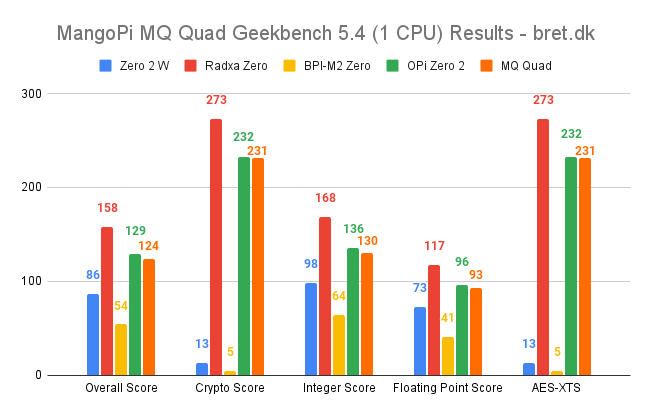
Multi-Core Performance
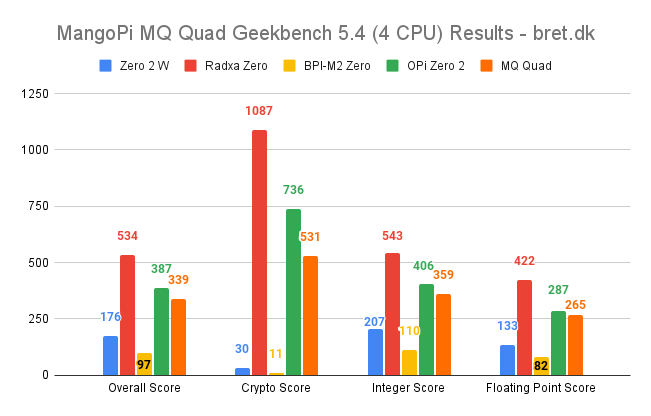
PHPBench
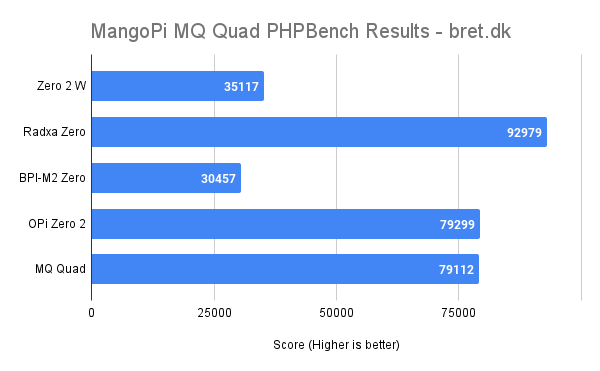
PyBench
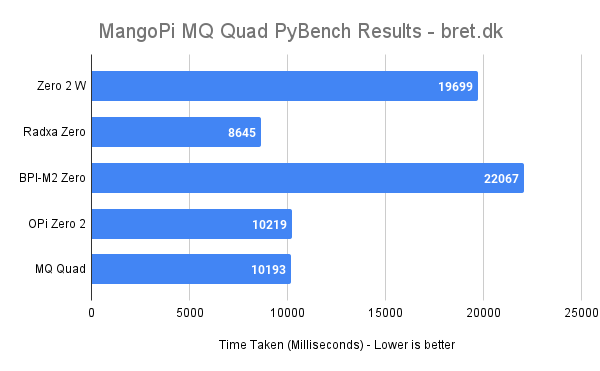
WavPack Audio Encoding
The BananaPi M2 Zero wouldn’t complete a run of the same WavPack test here, though an older test was completed in 121 seconds.
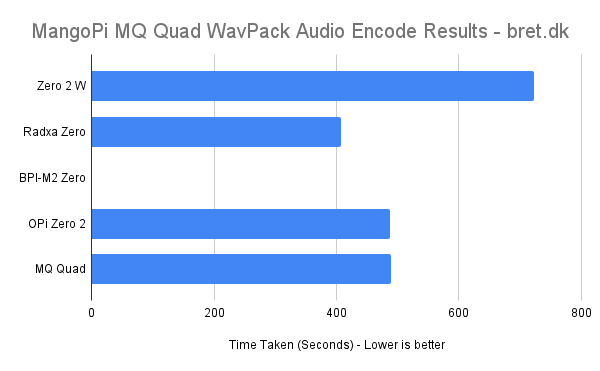
Crypto++
Measured in MiB/s, this is a useful test of each SoC’s cryptographic abilities and whilst the S905Y2 in the Radxa Zero does take the lead in each test, the H616 is not too far behind.
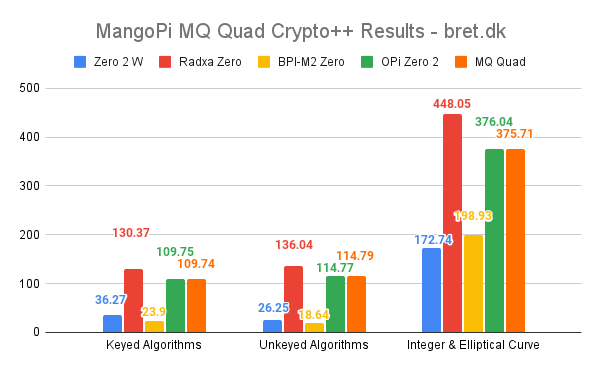
GZIP Compression
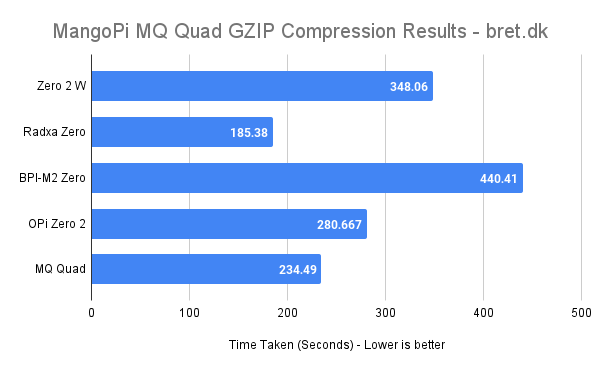
Memory (RAM) Performance
The MangoPi MQ Quad packs in 1GB of DDR3 memory which puts it ahead of the Raspberry Pi Zero 2 and BananaPi M2 Zero in that regard, though it’s on par with the OrangePi Zero 2 which is evident here.
CacheBench
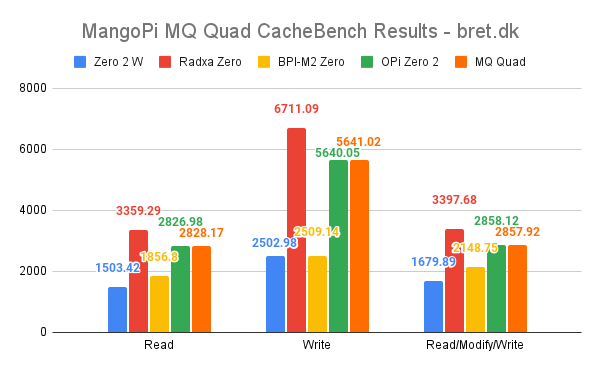
Geekbench 2.4.2 ARM RAM Tests
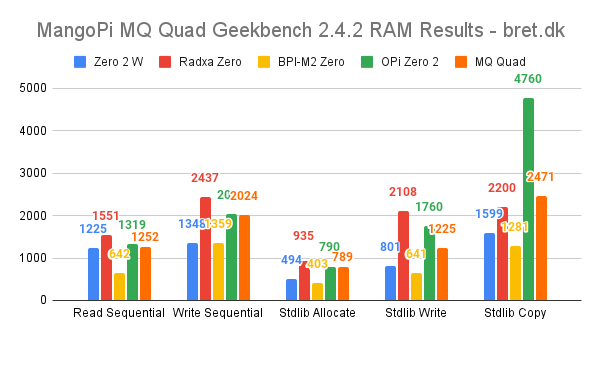
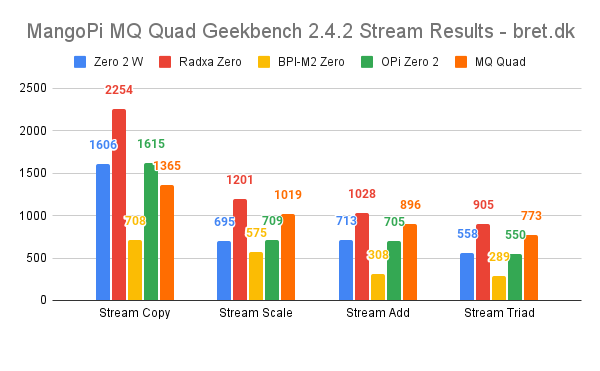
Networking Performance
When looking at the WiFi performance, the MangoPi MQ Quad puts in a fair performance. All tests were performed with the included WiFi antenna and it results in speeds pretty similar to those seen on the Raspberry Pi Zero 2. The OrangePi Zero 2 does beat it by 30%+ but that’s to be expected with its better WiFi chip.
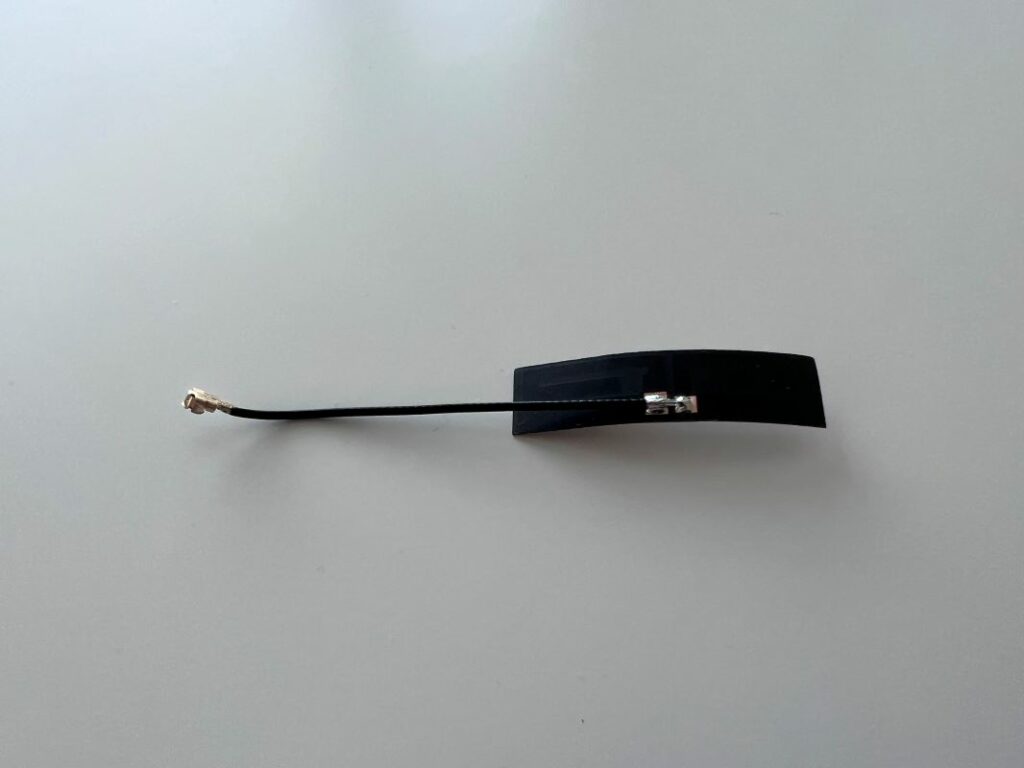
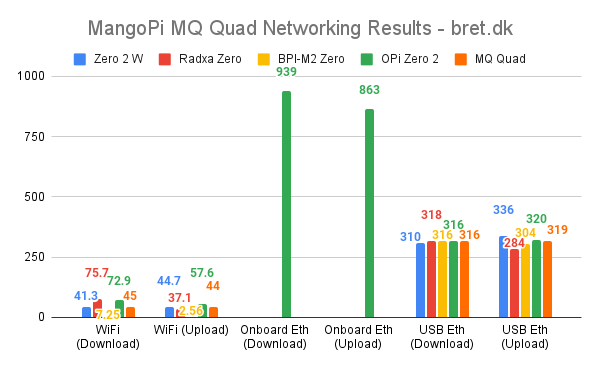
MQ Quad Storage Performance
MicroSD Card Reader
| SD Card Model | Sequential Read | Sequential Write | Random Read | Random Write | IOPing |
|---|---|---|---|---|---|
| SanDisk Ultra (8GB) | 12.77 MB/s | 13.27 MB/s | 5.47 MB/s | 0.63 MB/s | 0.84 ms |
| SanDisk Ultra (16GB) | 22.62 MB/s | 14.6 MB/s | 6.94 MB/s | 2.38 MB/s | 2.62 ms |
| SanDisk Ultra (32GB) | 22.63 MB/s | 18 MB/s | 7.18 MB/s | 2.08 MB/s | 2.65 ms |
| SanDisk Extreme (64GB) | 22.65 MB/s | 22.1 MB/s | 6.21 MB/s | 3.48 MB/s | 0.68 ms |
| SanDisk Extreme PRO (128GB) | 22.56 MB/s | 22.15 MB/s | 5.37 MB/s | 3.65 MB/s | 0.7 ms |
| Kingston Canvas Select Plus (32GB) | 11.4 MB/s | 9.6 MB/s | 4.97 MB/s | 1.94 MB/s | 0.73 ms |
| KIOXIA EXCERIA (32GB) | 22.63 MB/s | 15.4 MB/s | 9.32 MB/s | 4.13 MB/s | 0.65 ms |
| Samsung EVO Plus (32GB) | 22.31 MB/s | 18.6 MB/s | 6 MB/s | 1.25 MB/s | 1.21 ms |
| Amazon Basics (64GB) | 22.78 MB/s | 22.4 MB/s | 10.05 MB/s | 4.47 MB/s | 0.96 ms |
| Verbatim Premium (16GB) | 22.61 MB/s | 11.8 MB/s | 8.29 MB/s | 2.38 MB/s | 0.8 ms |
| SanDisk MAX ENDURANCE (32GB) | 22.5 MB/s | 21.75 MB/s | 5.97 MB/s | 3.43 MB/s | 0.62 ms |
| Integral ultima PRO (64GB) | 22.82 MB/s | 22 MB/s | 8.81 MB/s | 3.78 MB/s | 1.05 ms |
| Patriot EP Series (64GB) | 22.63 MB/s | 19 MB/s | 7.16 MB/s | 2.37 MB/s | 0.71 ms |
| Kodak (64GB) | 22.54 MB/s | 19.6 MB/s | 3.53 MB/s | 0.74 MB/s | 0.78 ms |
| Intenso (64GB) | 22.78 MB/s | 22.05 MB/s | 9.81 MB/s | 3.78 MB/s | 0.95 ms |
| Transcend (32GB) | 22.61 MB/s | 13.3 MB/s | 8.96 MB/s | 2.44 MB/s | 0.59 ms |
| Samsung EVO Select (32GB) | 22.51 MB/s | 19.9 MB/s | 6.18 MB/s | 1.14 MB/s | 1.01 ms |
| Samsung PRO Plus (128GB) | 22.58 MB/s | 20.25 MB/s | 7.27 MB/s | 1.16 MB/s | 0.69 ms |
| SanDisk HIGH ENDURANCE (64GB) | 22.42 MB/s | 21.15 MB/s | 4.78 MB/s | 2.5 MB/s | 0.69 ms |
| Samsung PRO Endurance (32GB) | 22.54 MB/s | 21.1 MB/s | 6.15 MB/s | 1.54 MB/s | 0.78 ms |
Average MicroSD Card Speed Comparison
This graph denotes all of the benchmarks combined and then averaged for this particular board, taken from my Best Raspberry Pi SD Cards piece so for an accurate picture of an individual card’s result, the table above will be better. This gives us a good idea of the average performance though and the MangoPi MQ Quad does well across the board.
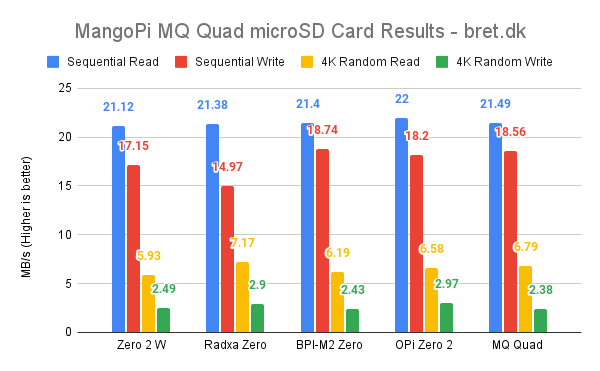
Thermals & Power
The Allwinner H616 is a warm lil thing and in every test, it’s hotter than its rivals in the lineup. Without any kind of cooling, it does reach quite high temperatures (all tests performed with an ambient temperature of 24.4c) and as a result, it does thermal throttle. At around 75c it dropped to 1.2GHz and at 80c it lowers further to 1GHz. As the temperature then fluctuates slightly above and below 80c it sits there floating between 1GHz and 1.2GHz. We’ll test out the offered heatsink in the full MQ Quad breakdown so make sure to look out for that next week!
MQ Quad Temperatures
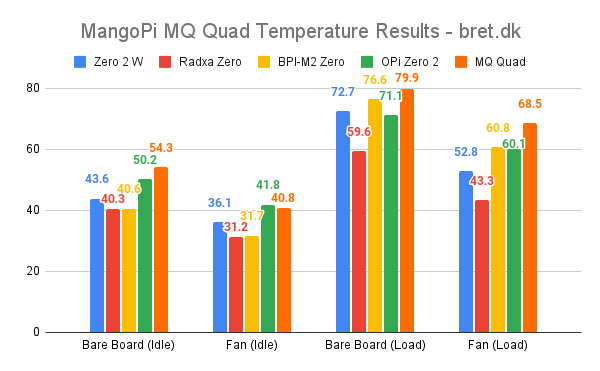
MQ Quad Power Draw
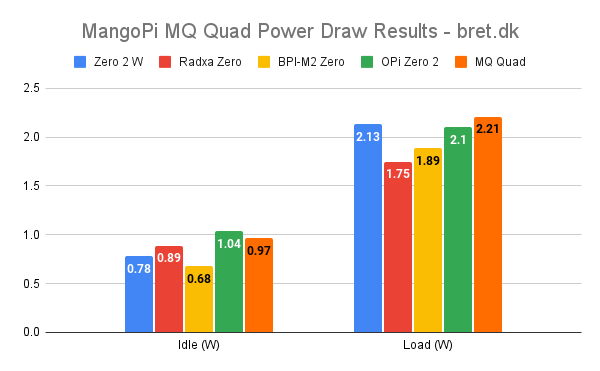
Final Thoughts
As expected, performance on the computing side of things is almost identical to the Orange Pi Zero 2 and that’s fine as they offer slightly different things beyond the SoC.
For example, if you’re looking for a Pi Zero form factor then the MangoPi MQ Quad is going to be what you want, providing you have the cooling or a lighter workload to go with it.
If you consider the networking capabilities a big thing in your purchasing decision then the OrangePi has onboard 1Gbit ethernet and faster WiFi (it also utilises 5GHz). This may prove useful to those wanting to run latency-specific, or throughput-heavy workloads.
Price-wise, the MQ Quad is going to set you back $25.76 USD for the board alone (plus any shipping/taxes in your region) and an additional $2.80 if you want the heatsink. The Orange Pi Zero 2 is slightly cheaper at $24.91 (they’re running an 11% discount at the time of writing) but offers no option to purchase a heatsink along with it. I did recently test OrangePi Zero heatsinks though so if you’re interested in adding one, do check that out.
Ultimately, the OrangePi Zero 2 is a more feature-rich board, is slightly cheaper, and has better software support (though I feel the MQ Quad will catch up on that front, it’s currently re-purposing OrangePi images!) whilst also offering more performance in certain areas. This was always going to be the case though with the MQ Quad being MangoPi’s first board like this and produced in much smaller quantities.
Which would you buy? Does the Pi Zero form factor sway it for you? Do you not care about the size and just want as many features as possible for the money? Let me know what you think in the comments and also let me know whether you have one of these and what you’re using it for!
4 comments
Not Bluetooth support yet, please mention it
Hi, Emilio! I didn’t think to mention it in this particular piece as I wasn’t testing Bluetooth functionality but in my upcoming full review of the MQ Quad, I’ll be sure to add this.
Another advantage the MangoPi boards have is the ability to make use of most of the boards created for use with the Raspberry Pi Zero pogo pins. WaveShare, MCUZone, Geekworm and Makerspot all make one or more boards that use pogo pins and work just fine with the MangoPi MQ Quad and the Mango Pi MQ Pro.
Yup! That’s a great addition to these and I’ve enjoyed testing some of those Waveshare and MCUZONE boards. They’re solid little options for getting more I/O!